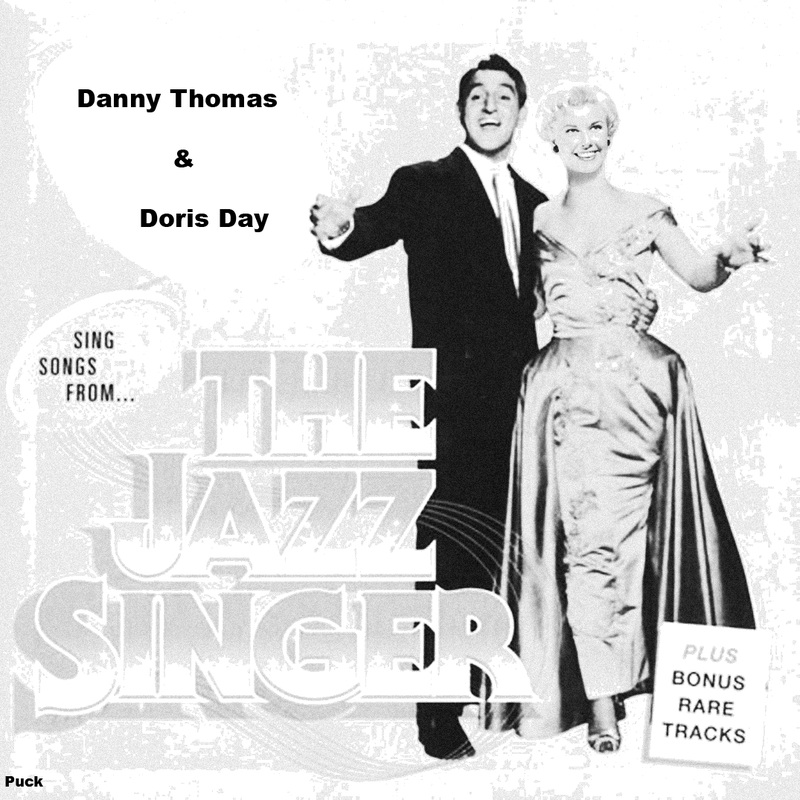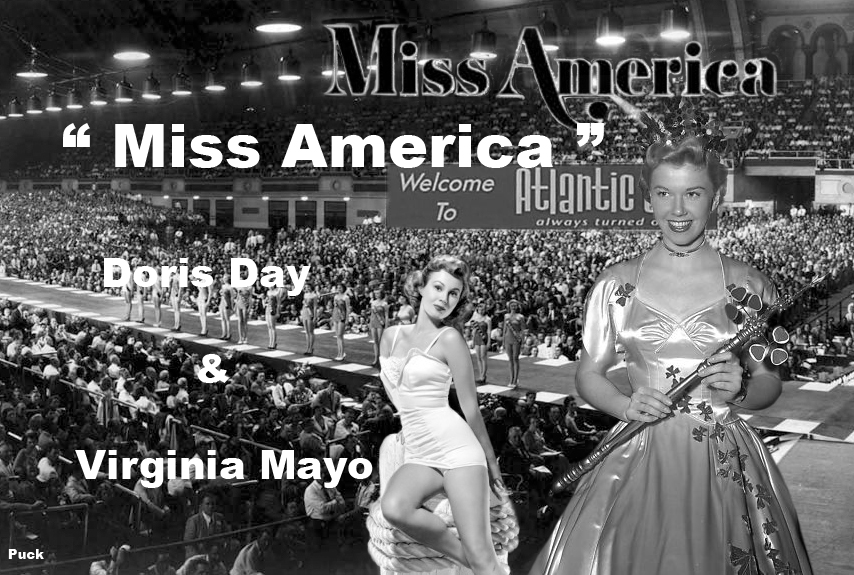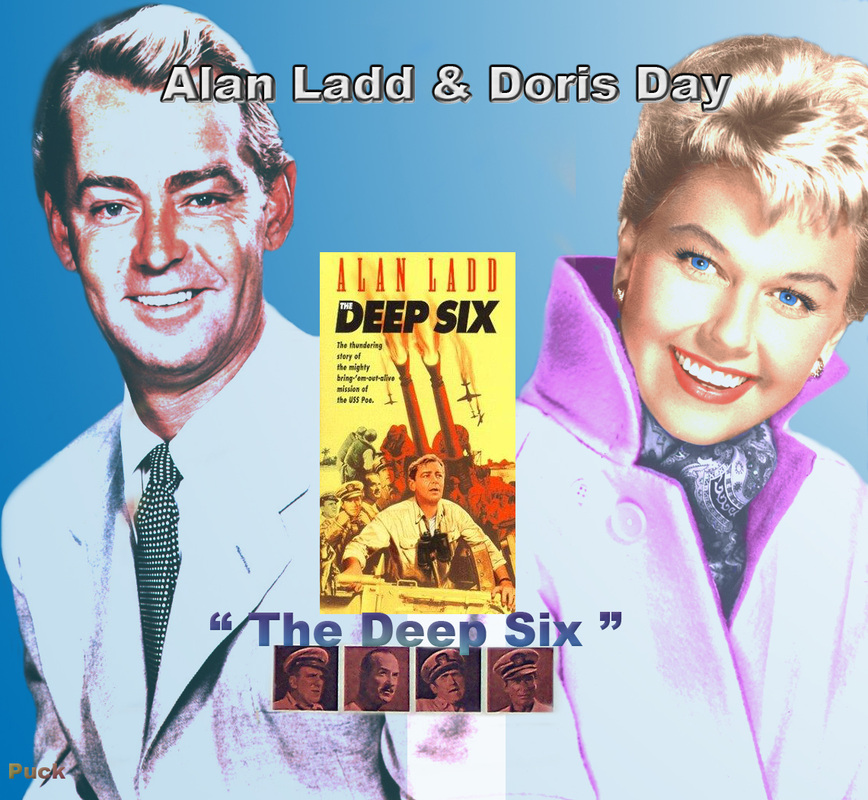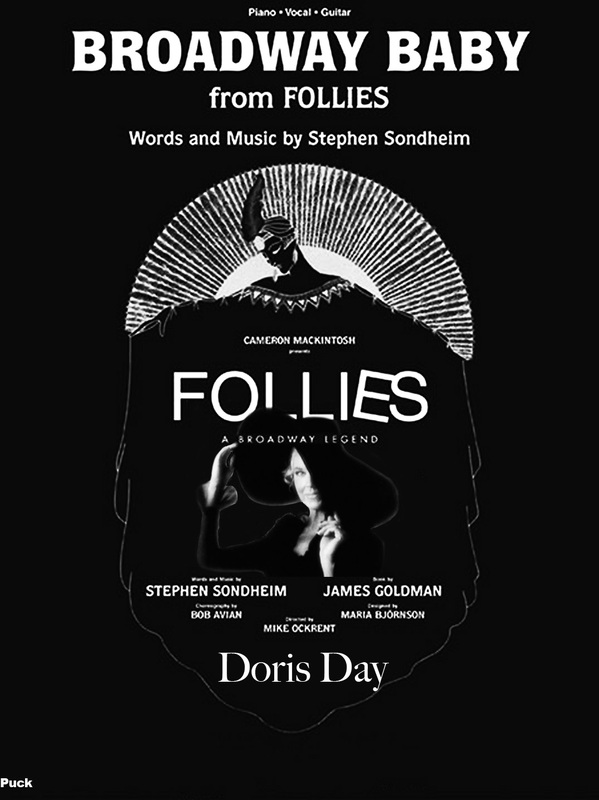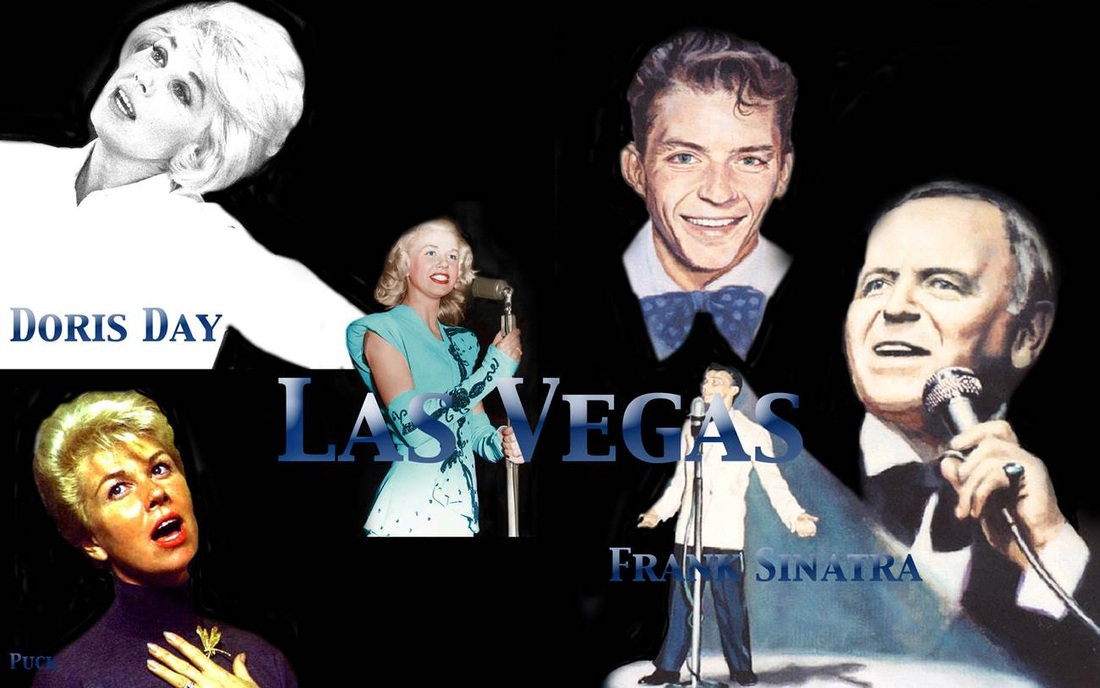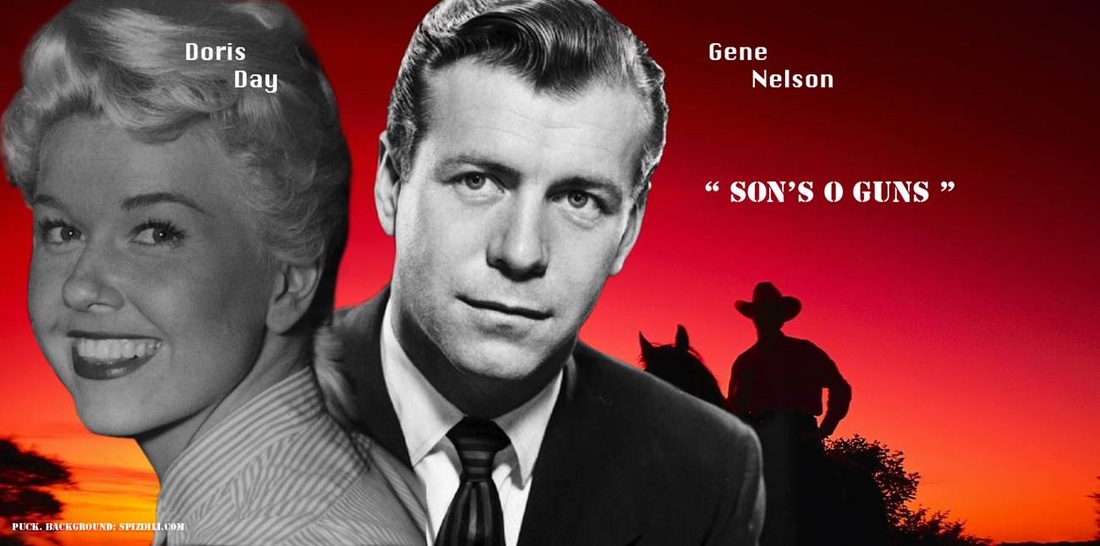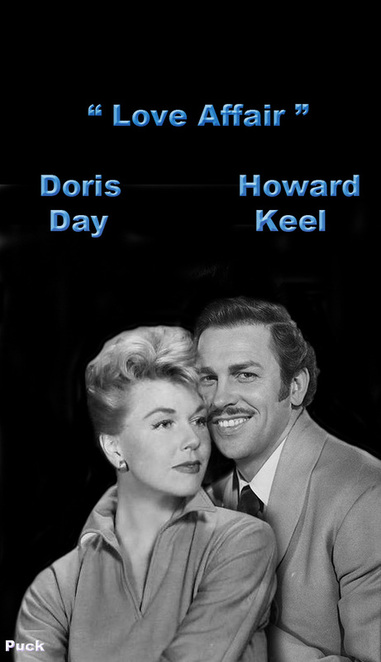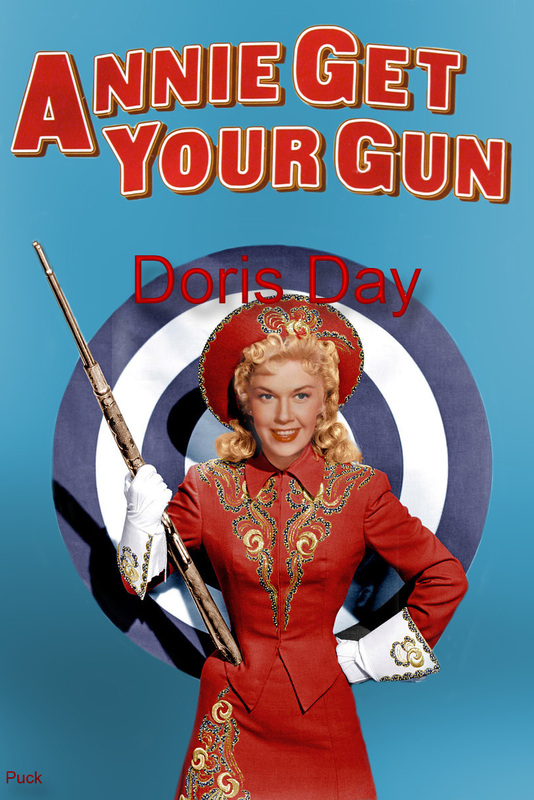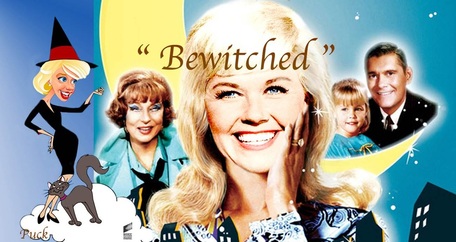WHO KNOWS WHAT MIGHT HAVE BEEN?
From the time Doris Day first appeared on the big screen, all the way through her entire career (and even today), she has been offered all kinds of roles in all phases of show business. Some of them seem funny to us today because the people who actually played some of the roles have become so identified with those parts (for example, Angela Lansbury in "Murder, She Wrote"), but the fact is, the role was offered to Doris first.
On this page, we present some of the things which never happened, even though they were actually printed as facts in newspapers over the years. We are grateful to our friend, PUCK GROENEWEG, from the Netherlands, who has created what might have been playbills or newspaper ads for some of the roles that were offered. You may ask why they were turned down but we can only guess at reasons for most of them. We DO know that the role of Mrs. Robinson in "The Graduate" was turned down because Doris did not want to play that kind of an immoral role (and it got Anne Bancroft an Oscar Nomination), and that her then husband/agent turned down the movie version of "South Pacific" because he felt that not enough money was offered for the part.
On this page, we present some of the things which never happened, even though they were actually printed as facts in newspapers over the years. We are grateful to our friend, PUCK GROENEWEG, from the Netherlands, who has created what might have been playbills or newspaper ads for some of the roles that were offered. You may ask why they were turned down but we can only guess at reasons for most of them. We DO know that the role of Mrs. Robinson in "The Graduate" was turned down because Doris did not want to play that kind of an immoral role (and it got Anne Bancroft an Oscar Nomination), and that her then husband/agent turned down the movie version of "South Pacific" because he felt that not enough money was offered for the part.
This movie actually happened and Danny Thomas was the male lead. The female lead went to Peggy Lee, for which she got critical acclaim.
Doris was actually offered this television role first. Later, when she was offered another TV comedy detective series, entertainment magazines like Variety said it was going to happen. We know that it never did. It would have been an interesting show, but we are certain that Angela Lansbury is happy Doris did not accept the show. Here are some other images from Puck for that show that never happened, at least with Doris in the title role:
For a period of time in the early 50's, there was talk of a vehicle that centered on a story developed around the heart of the Broadway stage. Doris would have been part of a large cast co-starring: Jack Carson, Gordon MacRae, Virginia Mayo, and Joan Crawford. It obviously never happened. How about a playbill, Puck?
Also in the 50's, there was talk of a movie expose' of The Miss America Beauty Pageant in Atlantic City. The movie would have co-starred Virginia Mayo. (WB seemed to think they made a good team; in reality, Doris rarely starred in a film with another blonde.)
The swim suit competition...
The evening gown competition
It was rumored that there were two pictures slated for Doris to star with Alan Ladd. The only titled one was "Deep Six". (We suspect the vast differences in their heights put the kabosh on this project.) The movie actually happened for Alan but not for Doris.
Dennis Morgan had costarred with Doris in "It's a Great Feeling". Gene Nelson had been in 3 or 4 other early films. Putting all three of them together would take care of both singing and dancing. It was supposed to be called "Painting the Clouds with Sunshine". (There were also other stars mentioned for the leads with Doris.)
There was also talk about a film with Gene Kelly, but it never happened, even with a working title of "Anniversary Waltz". Perhaps fans would have liked a song and dance movie (see Puck's image below), but that was not the intent. It would have been the screen version of a popular Broadway show about a couple married 15 years running into problems. Gene was a talked about co-star at MGM, but instead they finished off his contract by having him direct "Tunnel of Love" in which he did not star. "Waltz" had opened on Broadway in 1954 starring Kitty Carlisle.
Also touted was a supposed re-make of a 1938 film, this time to co-star Doris with Gordon MacRae again in a musical comedy revision of the earlier film called "Brother Rat".
It is a well known fact that both Doris and husband/agent Marty turned down the role of Mrs. Robinson in what became an Oscar-nominated performance (for Anne Bancroft) in "The Graduate". Hindsight: starring in this one could have opened up all kinds of opportunities for Doris in then current projects.
Ann Blyth, in her last film role, played the role proposed to Doris in the biopic of torch singer/actress, Helen Morgan, which co-starred Paul Newman. Doris did not like the story, but the film was critically acclaimed. It would have been an opportunity for Doris to re-unite with her very first film director, Michael Curtiz.
Another missed opportunity? Steven Sondheim, the famous Broadway composer and lyricist, had been writing a show since the mid 60's about the reunion of a group of entertainers who used to appear in the "follies" on the occasion of the demolition of a theatre in which they once performed. His idea was to make this the first Broadway appearance by Doris at a crucial time in her career, as she was performing in her last film. It didn't happen...not that Doris would have agreed to doing a live Broadway show...but it could have been wonderful. (It eventually starred Dorothy Collins from "Your Hit Parade" fame in the role designed for Miss Day, and opened in 1971.) Several years later, it was offered to Doris once again as a film role. She said "no", and it never happened for the star or the show, which was recently revived on Broadway starring Bernadette Peters.
Another Broadway show turned film was offered to Doris. It was to star her with Frank Sinatra once again. Instead, the role went to Shirley MacLaine.
Another film proposed for Doris had several working titles. "The Woman", "The Women" and "The Opposite Sex". This would have been a star-studded movie featuring some of Hollywood's top female stars. Of course, it never happened.
In 1956, "Auntie Mame" was released as a Broadway play starring Rosalind Russell, and it was a big box office hit. She later starred in the movie version in 1958 and received a Golden Globe and an Oscar Nomination. In 1966, the movie then became a Broadway Musical. The part was offered to Doris and turned down.

Once again, Angela Lansbury picked up on a role offered to Doris, and she won a Tony Award for Best Actress in a Musical that year, and "Mame" became one of the biggest Broadway Hits (and also starred Bea Arthur in a supporting role. ) In 1974, it was slated to become a movie musical.
Movie makers seldom used good sense when turning a Broadway show into a Musical, often replacing the very leads who made the show such a success with so-called "bigger names" to make the movie more profitable. That has worked in a couple instances (Doris in PAJAMA GAME, Richard Gere in CHICAGO) but in more cases, it has not turned into a successful venture (Frank Sinatra in GUYS AND DOLLS, Michael Douglas in A CHORUS LINE). Lansbury was not asked to do the movie role of "Mame". It was offered to Doris once again at a time when she would have been perfect for the part (the right age, both a film and a TV star at the time, and no movie roles for over 5 years). It could have been a comeback role in the movies and a gigantic box office success. (Doris could also have brought on a big record hit in what has become a perennial Christmas favorite now for Angela; the song "We Need A Little Christmas" was from this show. ) The answer was "no".
SO..."MAME" (the movie musical) became a gigantic flop starring Lucille Ball. She just did not have the talent for the role, and Bea Arthur in a supporting role could not save her or the movie . To this day, it has the reputation as the worst ever Broadway Show turned into a movie musical.
Movie makers seldom used good sense when turning a Broadway show into a Musical, often replacing the very leads who made the show such a success with so-called "bigger names" to make the movie more profitable. That has worked in a couple instances (Doris in PAJAMA GAME, Richard Gere in CHICAGO) but in more cases, it has not turned into a successful venture (Frank Sinatra in GUYS AND DOLLS, Michael Douglas in A CHORUS LINE). Lansbury was not asked to do the movie role of "Mame". It was offered to Doris once again at a time when she would have been perfect for the part (the right age, both a film and a TV star at the time, and no movie roles for over 5 years). It could have been a comeback role in the movies and a gigantic box office success. (Doris could also have brought on a big record hit in what has become a perennial Christmas favorite now for Angela; the song "We Need A Little Christmas" was from this show. ) The answer was "no".
SO..."MAME" (the movie musical) became a gigantic flop starring Lucille Ball. She just did not have the talent for the role, and Bea Arthur in a supporting role could not save her or the movie . To this day, it has the reputation as the worst ever Broadway Show turned into a movie musical.
More than once, Debbie Reynolds wound up in roles first offered to Doris. One of these was the Broadway Show based on the story Molly Brown, one of the survivors of the shipwrecked Titanic in 1912. The Broadway Show starred Tammy Grimes. The movie musical COULD HAVE starred Doris.
Fans world-wide would loved to have seen Doris Day live, in person, singing. Maybe even dancing some. Several times she was offered big money for just one or two performances in Las Vegas, including one offer to appear with Frank Sinatra. A combination concert was also suggested for Doris and Elvis, as was a possible recording together. At one point, she almost gave in, but in the end, it never happened. Just think: Doris Day, Live in Las Vegas. Talk about setting world records.
One movie musical has become an annual favorite in reruns on television, especially around holiday times. On Broadway, it starred Mary Martin. In the movies, it was Julie Andrews, and it really made her a major star. However...just think of Doris in THE SOUND OF MUSIC!
After the success of ROMANCE ON THE HIGH SEAS, it was reported that Doris would appear in a project called "The 49'ers" to be directed by Michael Curtiz. Nothing more was ever said about the movie or its script.
After the huge success of "Lullaby of Broadway" and the chemistry between the movie's co-stars, another project for Doris and Gene (involving even more dancing) in a kind of Western setting was being considered.
By 1960, Doris had appeared in several more explicit kinds of films than those in her early career. Offers were coming in by the dozens to the most popular film star in the world. Does this sound like the summary of a Doris film?
Based on a 1934 play by Lillian Hellman, The Children's Hour is set at an exclusive girl's school managed by two best friends. When one of the students is punished for one of her many misdeeds, the mean-spirited youngster rushes to her wealthy aunt and accuses them of having an "unnatural relationship." This results in a trial for libel (a lost case), and the trial takes its toll on the relationship between one of the women and her boyfriend.
The film was offered to Doris, James Garner and Katharine Hepburn. When it was released, it did star Garner but his co-stars were Audrey Hepburn and Shirley MacLaine.
Based on a 1934 play by Lillian Hellman, The Children's Hour is set at an exclusive girl's school managed by two best friends. When one of the students is punished for one of her many misdeeds, the mean-spirited youngster rushes to her wealthy aunt and accuses them of having an "unnatural relationship." This results in a trial for libel (a lost case), and the trial takes its toll on the relationship between one of the women and her boyfriend.
The film was offered to Doris, James Garner and Katharine Hepburn. When it was released, it did star Garner but his co-stars were Audrey Hepburn and Shirley MacLaine.
Honestly, of all the roles refused by Doris, and you can see there were many, we doubt that she would have considered this story for a second, especially considering the fact that she turned down "The Graduate" because of its immoral theme.
|
Before "April in Paris" was released, other projects to co-star Doris with Ray Bolger had been discussed, and one of these involved considerably more dancing between the stars.
The 1939 Irene Dunne-Charles Boyer romance , Love Affair, remade with Cary Grant and Deborah Kerr in 1957 as An Affair to Remember, also became a vehicle for real-life couple Warren Beatty and Annette Bening in a 1994 rendition. The well-worn story remains the same, as a man and a woman, both engaged to other people, fall madly in love while traveling, indulge in a brief but intense affair, then agree to part and sort out their feelings. They are to meet again at the top of the Empire State Building if their feelings persist, but a series of unfortunate circumstances threatens to keep the lovers apart. Another film, Sleepless in Seattle, also drew on An Affair to Remember for several of its most memorable sequences. The script for a 1950's version of the story was offered to Doris with Howard Keel, but Cary Grant and Deborah Kerr ended up doing the movie.
Actually, when Doris starred in a romantic film, it was almost always comedy ("Pillow Talk", "The Thrill of It All") or mystery ("Julie", "The Man Who Knew Too Much", "Midnight Lace".) No script selected in her long career essayed a purely romantic love story; those that did were considered musicals ("Young at Heart", "My Dream is Yours"). It might have been quite a different thing to see Doris in a hearbreaker with a happy ending like this one. Or for that matter, one that had an unhappy ending for a change! (She only ever died in one film, one in which she starred with former President Ronald Reagan, "Storm Warning".)
|
How about a combination of Doris Day and Carol Channing? Yes, that was proposed, too.
Elsie Janis (March 16, 1889 – February 26, 1956) was an American singer, songwriter, actress, and screenwriter. Entertaining the troops during World War I immortalized her as "the sweetheart of the AEF" (American Expeditionary Force). A film was proposed to tell her life story. It never happened.
"Annie Get Your Gun" is a musical with lyrics and music by Irving Berlin and a book by Dorothy Fields and her brother Herbert Fields. The story is a fictionalized version of the life of Annie Oakley (1860–1926), a sharpshooter who starred in Buffalo Bill's Wild West, and her romance with sharpshooter Frank Butler. The 1946 Broadway production was a hit starring Ethel Merman, and the musical had long runs in both New York (1,147 performances) and London, spawning revivals, a 1950 film version and television versions. Songs that became hits include "There's No Business Like Show Business", "Doin' What Comes Natur'lly", "You Can't Get a Man with a Gun", "They Say It's Wonderful", and "Anything You Can Do."
In 1950, Metro Goldwyn Mayer made a well-received movie version of the musical. Although MGM purchased the rights to the film version with an announced intention of starring legendary singer-actress Judy Garland as Annie, early work on the film was plagued with difficulties, some attributed to Garland. Garland was fired and replaced by the brassier, blonde Betty Hutton. (You may recall that Doris Day's very first film was, at first, a vehicle for Betty Hutton. Because Hutton was pregnant, she turned down the film and Doris got her first movie break).
That said, by 1950 Doris was well on her way to becoming one of the most popular female musical actresses in the world. Her name was, of course, mentioned for this film. But she was under contract to Warner Brothers Studios, and they were not interested in signing out their "golden goose" to any other studio. So...the idea of Doris as Annie with Howard Keel as Frank bit the dust.
In 1950, Metro Goldwyn Mayer made a well-received movie version of the musical. Although MGM purchased the rights to the film version with an announced intention of starring legendary singer-actress Judy Garland as Annie, early work on the film was plagued with difficulties, some attributed to Garland. Garland was fired and replaced by the brassier, blonde Betty Hutton. (You may recall that Doris Day's very first film was, at first, a vehicle for Betty Hutton. Because Hutton was pregnant, she turned down the film and Doris got her first movie break).
That said, by 1950 Doris was well on her way to becoming one of the most popular female musical actresses in the world. Her name was, of course, mentioned for this film. But she was under contract to Warner Brothers Studios, and they were not interested in signing out their "golden goose" to any other studio. So...the idea of Doris as Annie with Howard Keel as Frank bit the dust.
Forward to 1953. A different project. A movie just as popular. A song that became a classic. Of course, that was "Calamity Jane". Doris co-starred with Howard Keel (for the one and only time), and they were great together. The big song was "Secret Love", an Academy Award and Grammy Winner. So, three years later, WB produced their own version of a Western Musical, but the leads were Calamity and Wild Bill Hickock. In the UK, this was recently voted as England's favorite movie musical, beating out stalwarts like "Singing in the Rain" (which tops the list in the US).
Footnote: In 1963, Columbia Records did a series of in-studio cast re-recordings of various Broadway Shows. Teaming up with Robert Goulet and a full cast of others, the recording of "Annie Get Your Gun" was nothing short of brilliant. So Doris got to play Annie Oakley after all.
Footnote: In 1963, Columbia Records did a series of in-studio cast re-recordings of various Broadway Shows. Teaming up with Robert Goulet and a full cast of others, the recording of "Annie Get Your Gun" was nothing short of brilliant. So Doris got to play Annie Oakley after all.
When Albert Brooks was ready to film his popular Broadway play, he wanted a famous actress from the 1950s to play the role of Mother, and originally offered the role to retired actresses Nancy Reagan and Doris Day. Day refused; Reagan loved the script and considered coming out of retirement for her first acting role in more than 40 years, but decided instead to stay home and care for her husband, Ronald Reagan, who was suffering from Alzheimer's disease. Brooks then asked his good friend Carrie Fisher if she could send the script to her mother, Debbie Reynolds, who accepted the part, to critical acclaim.
Almost everyone thought immediately of Doris Day when casting began for the movie version of 'SOUTH PACIFIC'. The part was a perfect fit for Doris . Husband Marty Melcher, her agent, was asking for too much money so the producers ended up with Mitzi Gaylor. She did a nice job and the film was an okay interpretation of the Broadway show. Using Doris would have made in a monumental movie for all time. When Doris recorded her "Showtime" album, she selected a song from this show for the album which shows how perfectly her voice wraps around the songs. Here is Doris singing one of the major song hits from the show, "A Wonderful Guy".
And now, our Puck looks at some wished for movie memorabilia. In the first one, look how cleverly Puck was able to insert Doris in place of Mitzi in most of the images from the newspaper ad:
HELLO DOLLY on Broadway starred all kinds of people from Carol Channing and Pearl Bailey to Ginger Rogers and Betty Grable. Once again, when it was time to do the movie, Doris Day's name came out. As it turned out, Barbra Streisand got the role, and movie critics ever since have said that she was too young for the part, and it showed. Now for some wishful thinking...
In 1964, Doris was offered another Broadway Show,"Roar Like A Dove", which eventually starred Betsy Palmer. This could have been the Playbill.
40 carats centers around a middle-aged woman who goes on vacation in Greece, finds love with a much younger man, then abandons him to go back to her life in New York. However, she quickly finds out that her daughter is dating the same guy she left in Greece making for some awkward, humorous and embarrassing moments. Audrey Hepburn, Elizabeth Taylor, Joanne Woodward, Doris Day, Glenda Jackson, Shirley MacLaine, and Sophia Loren were all considered for the role of Ann Stanley before the original director (William Wyler) bowed out of the production. Liv Ullman eventually made the movie.
On the Broadway stage in 1968, the role was originated by Julie Harris, who won a Tony Award for her performance. Actresses such as June Allyson, Joan Fontaine and Zsa Zsa Gabor succeeded her on Broadway in the play, which ran for 780 performances.
On the Broadway stage in 1968, the role was originated by Julie Harris, who won a Tony Award for her performance. Actresses such as June Allyson, Joan Fontaine and Zsa Zsa Gabor succeeded her on Broadway in the play, which ran for 780 performances.
With the phenomenal success of PILLOW TALK in 1959, there were, of course, many scripts offered to co-star Doris with Rock Hudson and Tony Randall again, and it happened twice more in LOVER COME BACK and SEND ME NO FLOWERS. However, there was also talk about a sequel to Pillow Talk, that never had a title, but the idea was to pick up the story 10 years later. Thus...PILLOW TALK 2.
In 1960, Dean Martin starred with Judy Holliday in the MGM movie musical of the 1956 successful Broadway show, "Bells Are Ringing". Going against the "usual" routine, the producers brought in the Broadway star, Judy, but replaced the male lead with Dean Martin. It did not turn out to be a successful film for whatever reason. Judy was already sick (she died of cancer) while filming, and the chemistry between the co-stars was not evident. Here was another lost opportunity for a Doris Day Smash:
One of the songs from this musical is one of Miss Day's most popular recordings:
Do I Hear a Waltz? was a Broadway musical with a book by Arthur Laurents, music by Richard Rodgers, and lyrics by Stephen Sondheim. It was adapted from Laurents' 1952 play The Time of the Cuckoo, which was the basis for the 1955 film Summertime starring Katharine Hepburn. A film version of the musical was offered to Doris, but she turned it down.
Wildcat was a musical with a book by N. Richard Nash, lyrics by Carolyn Leigh, and music by Cy Coleman. The original production opened on Broadway in 1960, starring a 48-year-old Lucille Ball in her only Broadway show, which was not well received and closed because of announced "illnesses" on the part of he star. Doris would have been perfect for this part, but no film was ever made once she said "no".
SOMETHING ELSE THAT NEVER HAPPENED. A film classic, The African Queen, was a 1951 adventure film adapted from the 1935 novel of the same name by C. S. Forester. The film was directed by John Huston. The screenplay was adapted by James Agee, John Huston, John Collier and Peter Viertel. It was photographed in Technicolor by Jack Cardiff and had a music score by Allan Gray. The film starred Humphrey Bogart (who won the Academy Award for Best Actor – his only Oscar), and Katharine Hepburn along with Robert Morley, Peter Bull, Walter Gotell, Richard Marner and Theodore Bikel. The re-imagining of this as a musical leaves us to wonder what might have been.
In March of 1989, the following information appeared in several Hollywood Reporter types of magazines:
March 16, 1989:
Q.What's this we hear about Doris Day making a movie comeback? Will it be a singing part?
A. Day, 64, has been semi-retired for quite a while now. It's not that she doesn't want to work before the cameras, she tells me; it's just that she can't find a script to her liking. Things are looking up, though. Hollywood insiders assure me Doris will return to the screen in a flick titled Sleeping Dogs. She will play the heavy dramatic part of a mute woman sentenced to a mental institution for a crime she didn't commit.
From Liz Smith's column - October 25, 1988
"Doris Day has been lured back to make a movie, "Sleeping Dogs". Day is widely known as a friend to animals."
"I Do! I Do!" takes place entirely in a bedroom dominated by a couple's four poster bed. The story takes them through fifty years of marriage, through happiness and sorrow, through good times and bad, through childbirth, parenthood, and the eventual sadness from the absence of their children. In the end, they face the future together, while remembering their past.
For producer David Merrick, who initially presented the play on Broadway, I Do! I Do! was an ideal investment in that it had neither expensive sets and costumes nor a large cast. After four previews, the Broadway production, directed and choreographed by Gower Champion, opened on December 5, 1966 at the 46th Street Theatre, and closed on June 15, 1968 after 560 performances. Mary Martin and Robert Preston comprised the original cast. Carol Lawrence and Gordon MacRae played matinees starting in October 1967 and then replaced Martin and Preston in December 1967.
A film adaptation, written by Champion, was proposed for Doris Day and Rock Hudson, who turned it down. Then it was announced for Julie Andrews and Dick Van Dyke in 1969 but, following the commercial failure of several movie musicals, the project was abandoned in the spring of 1970.
In the early years of the 2000's, when "Bewitched" was first being discussed as a big screen movie, Julia Roberts was to play Samantha. She very much wanted to do so. She also wanted Doris Day to play Endora. She personally contacted Doris and asked her whether she had an interest. Doris told her no thank you. As a result, Julia did not want to do the film. It ended up starring Nicole Kidman with Shirley MacLaine as Endora. Much as the casting of Doris with Julia would have been a box office smash, the actual film version was not successful.
Our image artist (Miss Puck) actually liked the idea of Doris in the main role, as you can see below:
Show Boat is a 1951 American musical romantic drama film based on the stage musical of the same name by Jerome Kern (music) and Oscar Hammerstein II (script and lyrics), and the 1926 novel by Edna Ferber. This 1951 film version was adapted for the screen by John Lee Mahin, and was directed by George Sidney. Filmed previously in 1929 and in 1936, this third adaptation of Show Boat was shot in Technicolor in the typical MGM lavish style. The film stars Kathryn Grayson Ava Gardner, and Howard Keel, with Joe E. Brown, Marge Champion, Gower Champion, William Warfield, Robert Sterling, Agnes Moorehead and Leif Erickson. Unlike the 1936 film, none of the members of the original Broadway cast of the show appeared in this version. The 1951 Show Boat was the most financially successful of the film adaptations of the show: one of MGM's most popular musicals, it was the third most profitable film of that year. (It has been rumored in some circles that Doris was offered a role in this film, but there is no evidence that she ever was, especially since Warner's had balked before at loaning her out for any films at MGM. But our visualizer, Miss Puck, likes to dream anyway....
|
Since the songs in the film are written for the voice of a pretty high soprano, Doris certainly would not have been in the Kathryn Grayson role. And we personally doubt that she would have taken the Gardner role. Interesting highlight; Ava had turned down a couple roles that were later played by Miss Day!
|

Chris Christofferson (George F. Marion), the alcoholic skipper of a coal barge in New York, receives a letter from his estranged twenty-year-old daughter Anna "Christie" Christofferson (Greta Garbo), telling him that she'll be leaving Minnesota to stay with him. Chris left Anna to be raised by relatives on a St. Paul farm 15 years before, and hasn't seen her since.
Anna arrives an emotionally wounded woman with a dishonorable, hidden past: she has worked in a brothel for two years. One night, Chris rescues Matt (Charles Bickford) and two other displaced sailors from the sea. Anna and Matt soon fall in love and Anna has the best days of her life. But when Matt proposes to her, she is reluctant and haunted by her recent past. Matt insists and compels Anna to tell him the truth. She opens her heart to Matt and her father, disclosing her dark secrets.
Does not sound like the plot of a typical Doris Day film, but she was offered the Garbo part when there was talk of bringing the novel to the screen as a musical, the same one that opened on Broadway called "New Girl in Town",
Anna arrives an emotionally wounded woman with a dishonorable, hidden past: she has worked in a brothel for two years. One night, Chris rescues Matt (Charles Bickford) and two other displaced sailors from the sea. Anna and Matt soon fall in love and Anna has the best days of her life. But when Matt proposes to her, she is reluctant and haunted by her recent past. Matt insists and compels Anna to tell him the truth. She opens her heart to Matt and her father, disclosing her dark secrets.
Does not sound like the plot of a typical Doris Day film, but she was offered the Garbo part when there was talk of bringing the novel to the screen as a musical, the same one that opened on Broadway called "New Girl in Town",
The West Side Waltz is a play by Ernest Thompson. It focuses on Margaret Mary Elderdice, an aging, widowed pianist living in a dreary Upper West Side apartment, and her relationships with a prim, virginal violinist neighbor and the young companion who moves in for an extended stay.
Thompson was prompted to write the piece when screenwriter George Seaton offered him a grant to write a new play following the success of his previous work, On Golden Pond.
The play originally was presented off-Broadway in 1978. After three previews, the Broadway production, directed by Noel William, opened on November 19, 1981 at the Ethel Barrymore Theatre. Despite the presence of screen legend Katharine Hepburn, supported by Dorothy Loudon, Regina Baff, and David Margulies, it ran for only 126 performances. Hepburn was nominated for a Tony Award for Best Actress in a Play, but lost to Zoe Caldwell (Medea).
Thompson wrote the teleplay for and directed a CBS production that originally aired on Thanksgiving night in 1995. The cast included Shirley MacLaine, Liza Minnelli, Kathy Bates, Jennifer Grey, Estelle Harris, and Robert Pastorelli. Once again, Doris was offered a part she turned down.
Thompson was prompted to write the piece when screenwriter George Seaton offered him a grant to write a new play following the success of his previous work, On Golden Pond.
The play originally was presented off-Broadway in 1978. After three previews, the Broadway production, directed by Noel William, opened on November 19, 1981 at the Ethel Barrymore Theatre. Despite the presence of screen legend Katharine Hepburn, supported by Dorothy Loudon, Regina Baff, and David Margulies, it ran for only 126 performances. Hepburn was nominated for a Tony Award for Best Actress in a Play, but lost to Zoe Caldwell (Medea).
Thompson wrote the teleplay for and directed a CBS production that originally aired on Thanksgiving night in 1995. The cast included Shirley MacLaine, Liza Minnelli, Kathy Bates, Jennifer Grey, Estelle Harris, and Robert Pastorelli. Once again, Doris was offered a part she turned down.

Nellie Bly (May 5, 1864– January 27, 1922) was the pen name of American journalist, Elizabeth Jane Cochrane. She was a ground-breaking reporter known for a record-breaking trip around the world in emulation of Jules Verne's character Phileas Fogg, and an exposé in which she faked insanity to study a mental institution from within. In addition to her writing, she was also an industrialist and charity worker. Bly was also the subject of a 1946 Broadway musical by Johnny Burke and Jimmy Van Heusen, which was also offered as a film possibility for Doris. Obviously, it never happened.

Mary, Mary is a play by Jean Kerr. The play became one of the longest-running productions of the decade. After two previews, the Broadway production opened on March 8, 1961 at the original Helen Hayes Theatre (demolished in 1982), where it ran for nearly three years and nine months before transferring to the Morosco where it closed in December 1964, after 1572 performances. Directed by Joseph Anthony, the original cast starred Barbara Bel Geddes as Mary, Barry Nelson as Bob, Michael Rennie as Dirk, John Cromwell as Oscar, and Betsy Von Furstenberg as Tiffany. Bel Geddes was nominated for the Tony Award for Best Actress in a Play.
Richard L. Breen adapted Kerr's play for a 1963 film version directed by Mervyn LeRoy. Nelson, Rennie, and Sherman reprised their stage roles, with Debbie Reynolds as Mary and Diane McBain as Tiffany. Once again, Reynolds picked up on a role offered first to Doris Day, who turned it down. It opened at Radio City Music Hall to lukewarm reviews. The play ran far longer than the movie.
Another projected film mentioned for Doris Day was tentatively called "FIFTH AVENUE DOLL". Little else is know about that movie, but our special artist, Puck, likes the idea anyway!
When "PILLOW TALK" and "LOVER COME BACK" were topping box office grosses, there was much talk about more films for Doris and Rock as co-stars. Here were some of them:
All kinds of scripts were mentioned for Doris, many of which were just titles...pipe dreams that never happened.
|
Josh Logan could not get Doris for "South Pacific"; he really tried. But although he never gave up hope, a film with him and Doris never happened.
The same is true of Doris with Dean Martin. That pairing was suggested more than once...again, it never happened. They could have made beautiful music together. |
